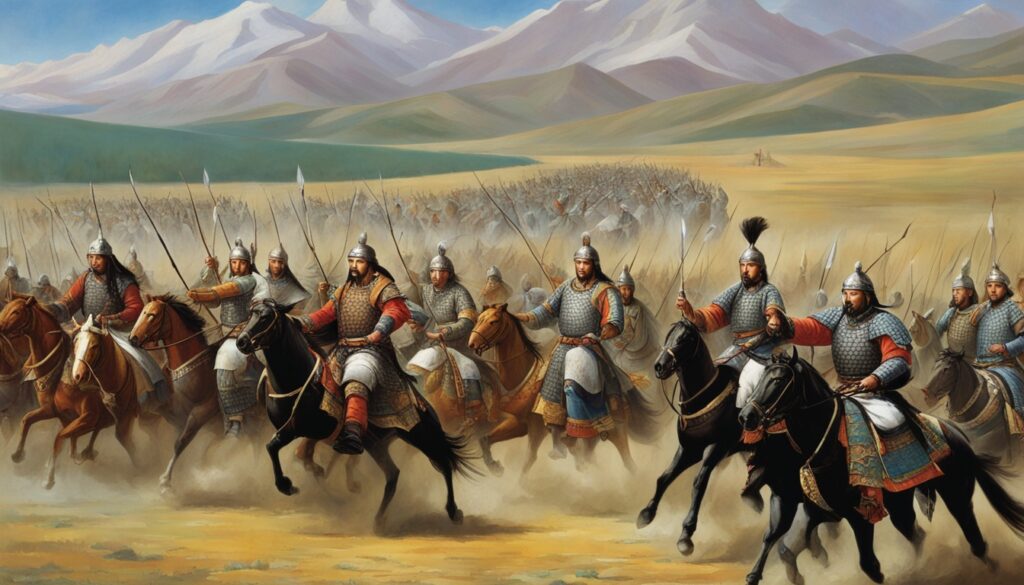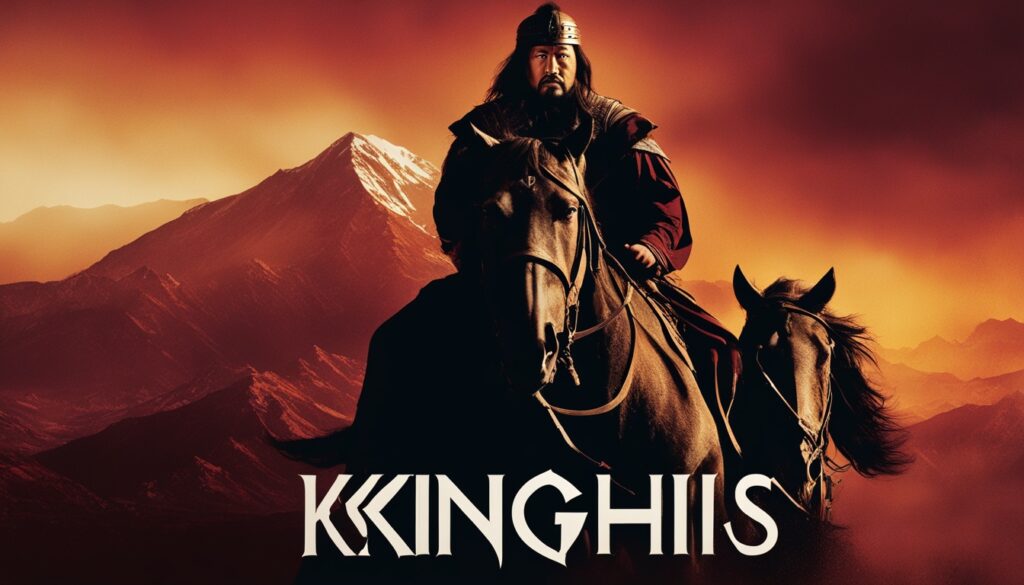Genghis Khan is a giant in world history. He was a Mongol ruler who built the biggest empire in history. Born as Temüjin, he started from humble beginnings. He united the Mongol tribes and expanded his empire greatly.
Genghis Khan’s story shows how ambition, strategy, and determination can lead to greatness. He faced many challenges early on in his life. His military campaigns changed the world, making him known as the “Conqueror of the World.”
Rise of the Mongol Empire
The story of the Mongol Empire’s rise to power is linked to Genghis Khan’s life. Born as Temüjin, he faced many challenges early on. These hardships shaped his life among the Mongol tribes.
Genghis Khan’s Early Life
Genghis Khan started his journey in the Khentii Mountains of today’s Mongolia. After his father’s murder, he was forced into exile. Despite this, he showed great leadership skills, building strong alliances and followers among the Mongols.
Unification of Mongol Tribes
Genghis Khan united the Mongol tribes with his military skills and strategic thinking. By the early 13th century, he became the top leader of the Mongols. This led to the Mongol Empire’s fast growth, covering from the Sea of Japan to the Black Sea.
Under Genghis Khan, the Mongol Empire became a key moment in history. It set the stage for one of the biggest and most influential empires in history.
Conquests and Military Campaigns
Genghis Khan was a master of war and strategy. His military campaigns quickly grew the Mongol Empire. He used new tactics, disciplined troops, and a strong will to beat his enemies.
Invasion of Northern China
Genghis Khan’s invasion of Northern China was a key event. He wanted the region’s wealth and resources. So, he planned a detailed campaign to take control.
His army was known for its speed, strength, and teamwork. They quickly defeated the Chinese, taking cities and key places.
This showed Genghis Khan’s skill in war. His troops were trained in Mongol tactics like cavalry and archery. They could fight well in different places and weather.
Genghis Khan was smart in keeping his new lands. He used politics, military power, and good government to keep control. This helped him expand his empire into Northern China.
Genghis Khan’s Legacy
Genghis Khan’s rule and the Mongol Empire’s reach were huge. He created the Pax Mongolica, a time of peace and stability in Eurasia.
Pax Mongolica
The Pax Mongolica was a time of great connection between cultures. Genghis Khan united the Mongols and expanded his empire. This led to a vast land empire, connecting people, goods, and ideas.
This created a space for cultural sharing and economic growth.
Impact on Trade and Culture
The Mongol Empire’s trade networks and stability changed global trade and culture. The Silk Road, a network of trade routes, linked the East and West. It brought goods, technologies, and ideas together.
This sharing of knowledge boosted art, architecture, and learning. Genghis Khan’s impact lasted long after he was gone. The Pax Mongolica and the Mongol Empire’s influence shaped the world, setting the stage for global trade and cultural exchange.
Historical Curiosities
Exploring the history of Genghis Khan and the Mongol Empire reveals many fascinating facts. These go beyond the famous conquests and military skills of this legendary leader. They give us a deeper look into this important time.
Genghis Khan loved ice cream, or so history tells us. He enjoyed a frozen dessert made from milk, flour, and fruit, packed in snow. This was a treat during the Mongol Empire’s peak.

The mystery of where Genghis Khan was buried is another fascinating fact. His final resting place is a secret, with many theories about it. This mystery has captured the interest of historians and adventurers.
The Mongols also brought new ideas and technologies to the West through their trade networks. They introduced paper money, a big change in global commerce.
These curiosities show the rich and complex legacy of Genghis Khan and the Mongol Empire. Learning about these lesser-known facts helps us appreciate their big impact on history.
Genghis Khan’s Personal Life
Genghis Khan, the legendary Mongol ruler, is famous for his military victories that built the vast Mongol Empire. His personal life shows us the man behind the legend. Born as Temüjin, he faced many challenges early on in his life.
His marriages and family were key to his success. He had many wives, but Borte was his first and most important. They had four sons who became leaders in the Mongol Empire. Genghis Khan believed in choosing leaders based on their skills, not just their family ties.
Many see him as a ruthless conqueror, but he had many personal qualities that helped him succeed. He was a great diplomat, making strong alliances and partnerships. He was open to new ideas, which helped him grow the Mongol Empire and encourage cultural exchange.
Genghis Khan valued the Mongol way of life deeply. He respected nature and believed in the strength of family and community. These values shaped his leadership and influenced Mongol society.
Looking into Genghis Khan’s personal life helps us understand the man behind the legend. He was a complex figure whose personal qualities and experiences greatly influenced the Mongol Empire.
Mongol Warfare Tactics
The Mongol Empire’s military was key to its fast growth and rule over vast lands. Their skilled cavalry and archery were central to their success. These tactics helped the Mongols defeat their foes and create a huge empire.
Use of Cavalry
The Mongols were famous for their skilled cavalry. They rode fast, strong horses, moving quickly over long distances. This let them surprise enemies and stay mobile in battles.
They worked together well, moving and fighting with precision. They could quickly change their plans, pretend to retreat, and then attack hard. This broke the enemy’s lines and stopped their advance.
Mastery of Archery
The Mongols were also known for their archery skills. Their archers could shoot many arrows accurately, even while moving. This made it hard for enemies to stand against them.
They also used archers to protect their sides and back. This “wall of fire” made it hard for enemies to get close or flank them.
Together, the Mongol cavalry and archers were a powerful force. They won many battles, helping the Mongols conquer a vast empire.
Fall of the Mongol Empire
The Mongol Empire, once vast under Genghis Khan, began to decline. Factors like internal struggles, governing a huge territory, and new powers challenging them played a part. These issues led to its downfall.
After Genghis Khan died, his sons and grandsons split the empire. This led to fights over who should rule, weakening the empire. The Golden Horde, Chagatai Khanate, and Yuan Dynasty became their own powers, fighting each other. This fighting used up the empire’s strength.
Running such a huge empire was hard. The Mongols faced problems with communication, transport, and managing different cultures. These issues slowly weakened the empire.
At the same time, powers like the Ming Dynasty, Timurid Empire, and Mamluk Sultanate grew strong. They took advantage of the Mongols’ problems, slowly taking back lands from them.
Together, these factors led to the Mongol Empire’s fall. It ended their time as top rulers in Eurasia.
Myths and Legends
Genghis Khan’s legacy is more than just his military victories and the rise of the Mongol Empire. Over time, myths and legends have grown around him and Mongol culture. These stories have made Genghis Khan a legendary figure.
Folklore Surrounding Genghis Khan
One myth says Genghis Khan was born with a blood clot in his hand, showing he was meant for greatness. Another legend claims he was conceived when his mother was hit by lightning, giving him special powers. These stories show the deep respect Mongols had for their leader.
Legends also talk about his amazing abilities. He could talk to animals and understand the natural world. He was known for being a great hunter and strategist, able to guess his enemies’ moves and the weather. These stories make Genghis Khan seem like a hero, embodying Mongol strength and resilience.
The stories about his life and death are just as intriguing. Some say he was taken to the heavens by a golden eagle, while others believe he was buried secretly to keep its location hidden. These tales add to the mystery and fascination around Genghis Khan.
Genghis Khan’s Descendants
Genghis Khan’s legacy lives on through his Mongol lineage spread across the globe. Genetic studies show that many people worldwide can trace their ancestry back to him. This makes him one of the most influential figures in human history.
Spread of the Mongol Lineage
Genghis Khan’s descendants and the Mongol Lineage have deeply influenced human genetics. It’s estimated that up to 8% of men in the former Mongol Empire’s region carry Y-chromosomes from Genghis Khan. This shows the vast impact of his genetic legacy over generations.
The Mongol Lineage has reached far beyond the Mongol Empire’s borders. Genghis Khan’s descendants are found in Asia, Europe, and even the Americas. This shows the Mongols’ military strength and the wide reach of their conquests. They mixed with local populations, spreading their genetic traits.
The genetic legacy of Genghis Khan’s descendants is still fascinating to researchers and historians. It offers insights into human evolution and migration. The study of the Mongol people’s genetic history shows the lasting impact of Genghis Khan. It reminds us of the significant influence of this historical figure.
Genghis Khan in Popular Culture
Genghis Khan, the legendary Mongol warrior, has made a big impact on popular culture. He’s been featured in epic films and captivating literature, reaching audiences all over the world. His huge personality and massive military campaigns have kept people interested for years.
The film “Mongol” (2007) is a key example of Genghis Khan’s influence. It tells the story of his early life and how he became a leader. Directed by Sergei Bodrov, it was up for an Academy Award, proving Genghis Khan’s global appeal.

Genghis Khan has also inspired many books. Writers have turned his life into stories and explored the depths of his rule. “Bones of the Master” by George Crane is one such book, looking at Genghis Khan through a modern Mongolian monk’s eyes.
He’s also made his mark on video games and TV series. In the “Civilization” video game series, players can lead the Mongol Empire, just like Genghis Khan. The History Channel’s “Genghis Khan” miniseries gives a detailed look at his life and times.
Genghis Khan’s lasting appeal in popular culture shows his lasting impact. Through movies, books, and other media, people keep learning about his life and achievements. This ensures Genghis Khan’s name stays alive for future generations.
Archeological Discoveries
In recent years, archeologists have made some amazing finds. These have changed what we know about the Mongol Empire and Genghis Khan. They have caught the interest of historians and the public, giving us a closer look at a key time in history.
One big find was Genghis Khan’s tomb in Mongolia. After a long search, researchers finally found where the great leader was buried. This has given us new insights into how he was buried and the riches he gathered during his rule. The items found have greatly expanded our understanding of the Mongol Empire’s culture and the wealth of its leaders.
Another exciting discovery is the Mongol military camps and battle sites. These digs have uncovered weapons, armor, and gear from Genghis Khan’s armies. This has helped experts learn more about the Mongols’ famous cavalry tactics, their archery skills, and their military strategies. These tactics helped them conquer vast lands.






